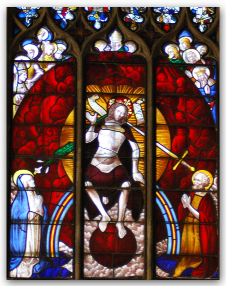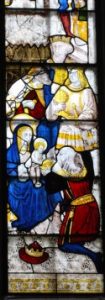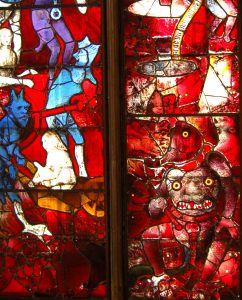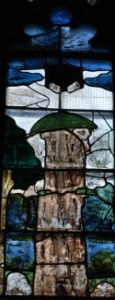 The stained-glass windows are of enormous interest because they are the only complete set of late medieval stained-glass windows remaining in any parish church in the country. The 28 windows form one complete, symmetrical scheme, of superb craftmanship and artistic interest, clearly made to a theological plan of what was to be illustrated and what position it should occupy. There’s a huge amount of symbolism and even small details are of significance. We can speculate why a particular episode or character has been included and what their position might tell. For example, what links the prophet David with the apostle James on the opposite side of the church?
The stained-glass windows are of enormous interest because they are the only complete set of late medieval stained-glass windows remaining in any parish church in the country. The 28 windows form one complete, symmetrical scheme, of superb craftmanship and artistic interest, clearly made to a theological plan of what was to be illustrated and what position it should occupy. There’s a huge amount of symbolism and even small details are of significance. We can speculate why a particular episode or character has been included and what their position might tell. For example, what links the prophet David with the apostle James on the opposite side of the church?
Experts agree that the windows were made between 1500 and around 1515. There’s no documentary evidence as to who commissioned or paid for the windows. John Tame died in 1500 so his son Edmund would have been in charge for the majority of the time the glass was being installed. He may have paid most of the cost but King Henry VII is thought to have been a patron and almost certainly the glass was made in London by a team of glaziers under the direction of Barnard Flower, King’s Glazier. One reason for thinking this is that some of the figures depicted are thought to be ‘donor portraits’ of Henry VII’s family.
The windows give a wonderful picture of the ideas and beliefs of the medieval period; a visual account of the Bible story from Adam and Eve to the last judgement. They were designed to be looked at like the pages of a picture history book, giving instruction as well as illumination, in both senses of the word. The story is told in 4 sections: – 1) Old Testament scenes foretelling coming events. 2) In the chancel, the most important part of the church, are scenes from the life of Christ and his mother. 3) Around the Nave are 56 different portraits of characters – Apostles, Saints, Martyrs, Prophets, Evangelists and Doctors of the Church. 4) Judgement, – the 3 West windows have the theme of judgement and mercy.
The church is dedicated to St Mary the Virgin, and the windows tell the story with particular emphasis on the Virgin Mary, whose role was of great importance.
Not many years after the windows were installed, the religious upheavals of the 16th century and the Reformation threatened their existence. Orders were given that all shrines, pictures, paintings and all other monuments in walls, glass windows, or elsewhere in churches or houses should be removed and destroyed. We don’t know how Fairford’s glass survived. Many statues were removed from the church, leaving empty niches, and the wall paintings were whitewashed over. It is likely that the windows too were whitewashed, as remains of whitewash have been noted on some of the pieces. Some of the faces have been removed and replaced later, and some of the windows may have been removed altogether during the Commonwealth period when the Puritans had similar instructions banning all statues and pictures. It’s also possible that the royal connections had some influence.
 It was an “act of God” that caused the greatest destruction to the windows. In November 1703 a great storm across southern England caused massive damage and loss of life. The three west-facing windows and two of the Apostles on the South side were damaged, and the vicar came in the following morning to find glass strewn across the floor. The windows were repaired as best they could but there were gaps and mistakes. At that time many stained-glass techniques and skills had been lost, since images in churches had been banned. It was not until the middle of the 19th Century, when the Gothic Revival brought new interest in the principles and techniques of stained glass, that people began to show concern about the state of the Fairford windows and call for restoration, and there was a move to repair the Great West Window (window 15). Chance Brothers of Smethwick were given the commission in 1863. After restoring the two Apostles (window 12) satisfactorily they were allowed to take away the top half of window 15. Instead of repairing it they brought back a replica as near as possible to the original but made of Victorian glass, which they thought was superior. This caused an outcry which ensured that in future, original material must not be replaced, only careful mending of leads and limited restoration would be allowed.
It was an “act of God” that caused the greatest destruction to the windows. In November 1703 a great storm across southern England caused massive damage and loss of life. The three west-facing windows and two of the Apostles on the South side were damaged, and the vicar came in the following morning to find glass strewn across the floor. The windows were repaired as best they could but there were gaps and mistakes. At that time many stained-glass techniques and skills had been lost, since images in churches had been banned. It was not until the middle of the 19th Century, when the Gothic Revival brought new interest in the principles and techniques of stained glass, that people began to show concern about the state of the Fairford windows and call for restoration, and there was a move to repair the Great West Window (window 15). Chance Brothers of Smethwick were given the commission in 1863. After restoring the two Apostles (window 12) satisfactorily they were allowed to take away the top half of window 15. Instead of repairing it they brought back a replica as near as possible to the original but made of Victorian glass, which they thought was superior. This caused an outcry which ensured that in future, original material must not be replaced, only careful mending of leads and limited restoration would be allowed.
 In 1940 the windows were removed for safety and placed in the cellars of Fairford Park House, which had been requisitioned by the Army, and the entrance bricked up. They were replaced in the church with minor repairs and re-leading from 1946-1947.
In 1940 the windows were removed for safety and placed in the cellars of Fairford Park House, which had been requisitioned by the Army, and the entrance bricked up. They were replaced in the church with minor repairs and re-leading from 1946-1947.
In 1986 Keith Barley was commissioned to begin a full conservation and restoration programme which began in 1988 and finished in 2010. Each window was taken out and carefully cleaned and repaired.  The ancient glass is no longer exposed to the attrition of the weather – an extra layer of clear glass has been added to protect the vulnerable old glass and prevent condensation by allowing air to circulate between the two layers. We hope the windows should now be good for a century or more.
The ancient glass is no longer exposed to the attrition of the weather – an extra layer of clear glass has been added to protect the vulnerable old glass and prevent condensation by allowing air to circulate between the two layers. We hope the windows should now be good for a century or more.
These wonderful windows have survived reformation, iconoclasm, civil wars, World Wars, the flight of Concorde, great storms and the ravages of time and decay for more than 500 years. We have almost no record of how Fairford’s glass managed to survive in earlier times, but we do know that the townspeople of today are determined to safeguard its future.
For additional information click on the following links:
Full details of all the windows are included in the Church Guidebook, and there is also a booklet about the Hidden Portraits. Both are available for sale, from the church office or in church.
Updated 29th March 2025 MB
